Peugeot Expert 2003 Manual Online
Manufacturer: PEUGEOT, Model Year: 2003, Model line: Expert, Model: Peugeot Expert 2003Pages: 128, PDF Size: 5.15 MB
Page 81 of 128

22-04-2003
AUDIO-SYSTEM132
GENERAL FUNCTIONS On / off
With the ignition key in the ACCESSORIES or IGNITION position, press the "M"button to switch the set on
or off.The set can operate for 30 minutes without switching the ignition on. ANTI-THEFT SYSTEM
The first time you use the set following disconnection of the set or the battery, you must enter the confiden- tial code which was given to you on handover of your vehicle. Entering the code Switch the set on.The display shows "CODE"then the set changes over to code request mode and "- - - -"is displayed.
Enter your four-digitcode number using buttons "1"to "6" .
For example: if your code is 5345 press buttons "5", "3" , "4" and "5"in turn.
When the fourth number has been entered correctly, the radio starts automatically. Error in entering the code
If an error is made when entering one of the first three digits, do not continue the operation and switch off the radio to prevent blocking it. Each incorrect code entry will result in the set being blocked for a period of from 5 seconds to 30 minutes,
after the 7th incorrect entry.
To unblock the set, leave it switched on during the waiting period. When "- - - -"is displayed, you can enter
the code again.
If the set is switched off during the waiting period, this waiting period will restart when the set is switched on again. After 14 incorrect code errors the radio will be permanently blocked. ADJUSTING THE SOUND Adjusting the volume
Turn the "M"button M to increase or decrease the volume of the set.
Page 82 of 128

AUDIO-SYSTEM133
AUDIO SETTINGS Press the ÒAUDIOÓbutton several times in succession to access the bass (BASS), treble (TREB) , loudness
(LOUD) , fader (FAD)and balance (BAL).
Exit from audio mode is automatic after a few seconds, without pressing any button or by pressing the ÒAUDIOÓ button after adjusting the balance.
Note: the bass and treble settings are specific to each source. It is possible to set the radio, CD, or CD* multi-
changer differently. Bass setting When ÒBASSÓ is displayed, press the ÒDÓor ÒEÓ buttons to vary the setting.
- ÒBASS Ð9Ó for a minimum bass setting,
- ÒBASS 0Ó for a normal position,
- ÒBASS +9Ó for a maximum bass setting.
Treble settingWhen ÒTREBÓ is displayed, press the ÒDÓor ÒEÓ buttons to vary the setting.
- ÒTREB Ð9Ó for a minimum treble setting,
- ÒTREB 0Ó for a normal position,
- ÒTREB +9Ó for a maximum treble setting.
Adjusting the loudness
This function automatically emphasises bass and treble tones when the volume is low. Press the ÒDÓor ÒEÓ buttons to switch this function on or off.
Setting the front/rear sound distribution (Fader) When ÒFADÓ is displayed, press the ÒDÓor ÒEÓ buttons to vary the setting.
The ÒDÓbutton increases the volume at the front.
The ÒEÓbutton increases the volume at the rear.
Setting the right/left sound distribution (Balance)When ÒBALÓ is displayed, press the ÒDÓor ÒEÓ buttons to vary the setting.
The ÒDÓbutton increases the volume on the right-hand side.
The ÒEÓbutton increases the volume on the left-hand side.
* Depending on equipment
22-04-2003
Page 83 of 128
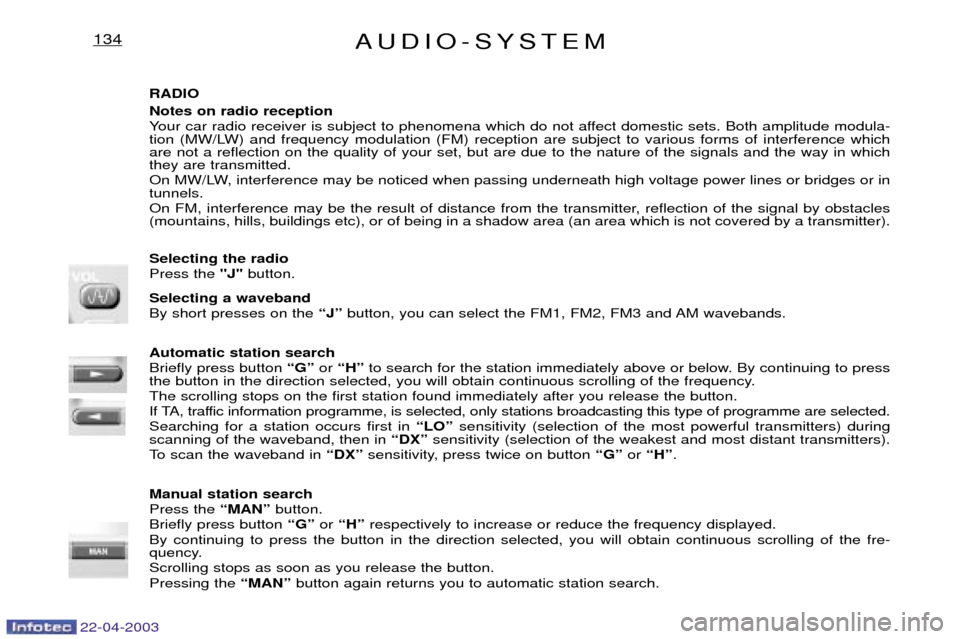
AUDIO-SYSTEM134
RADIO Notes on radio reception
Your car radio receiver is subject to phenomena which do not affect domestic sets. Both amplitude modula-
tion (MW/LW) and frequency modulation (FM) reception are subject to various forms of interference whichare not a reflection on the quality of your set, but are due to the nature of the signals and the way in whichthey are transmitted.
On MW/LW, interference may be noticed when passing underneath high voltage power lines or bridges or in tunnels.
On FM, interference may be the result of distance from the transmitter, reflection of the signal by obstacles (mountains, hills, buildings etc), or of being in a shadow area (an area which is not covered by a transmitter). Selecting the radio Press the "J"button.
Selecting a wavebandBy short presses on the ÒJÓ button, you can select the FM1, FM2, FM3 and AM wavebands.
Automatic station searchBriefly press button ÒGÓor ÒHÓ to search for the station immediately above or below. By continuing to press
the button in the direction selected, you will obtain continuous scrolling of the frequency.The scrolling stops on the first station found immediately after you release the button.
If TA, traffic information programme, is selected, only stations broadcasting this type of programme are selected.Searching for a station occurs first in ÒLOÓsensitivity (selection of the most powerful transmitters) during
scanning of the waveband, then in ÒDXÓsensitivity (selection of the weakest and most distant transmitters).
To scan the waveband in ÒDXÓsensitivity, press twice on button ÒGÓor ÒHÓ .
Manual station searchPress the ÒMANÓbutton.
Briefly press button ÒGÓor ÒHÓ respectively to increase or reduce the frequency displayed.
By continuing to press the button in the direction selected, you will obtain continuous scrolling of the fre-
quency. Scrolling stops as soon as you release the button.Pressing the ÒMANÓbutton again returns you to automatic station search.
22-04-2003
Page 84 of 128
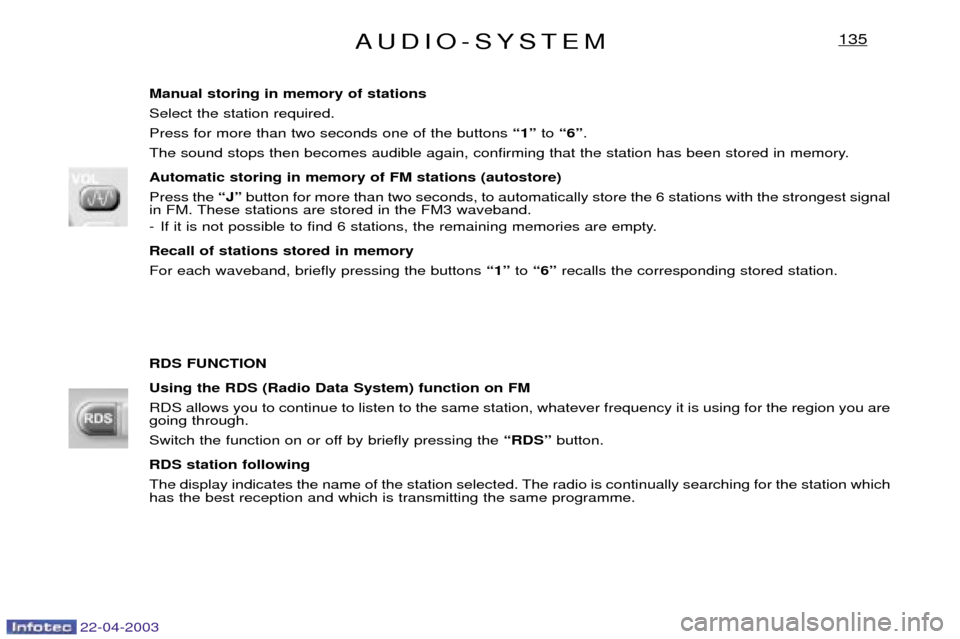
AUDIO-SYSTEM135
Manual storing in memory of stations Select the station required.Press for more than two seconds one of the buttons Ò1Óto Ò6Ó .
The sound stops then becomes audible again, confirming that the station has been stored in memory. Automatic storing in memory of FM stations (autostore) Press the ÒJÓbutton for more than two seconds, to automatically store the 6 stations with the strongest signal
in FM. These stations are stored in the FM3 waveband.
- If it is not possible to find 6 stations, the remaining memories are empty. Recall of stations stored in memory For each waveband, briefly pressing the buttons Ò1Óto Ò6Ó recalls the corresponding stored station.
RDS FUNCTION Using the RDS (Radio Data System) function on FM RDS allows you to continue to listen to the same station, whatever frequency it is using for the region you are going through.
Switch the function on or off by briefly pressing the ÒRDSÓbutton.
RDS station following
The display indicates the name of the station selected. The radio is continually searching for the station which has the best reception and which is transmitting the same programme.
22-04-2003
Page 85 of 128
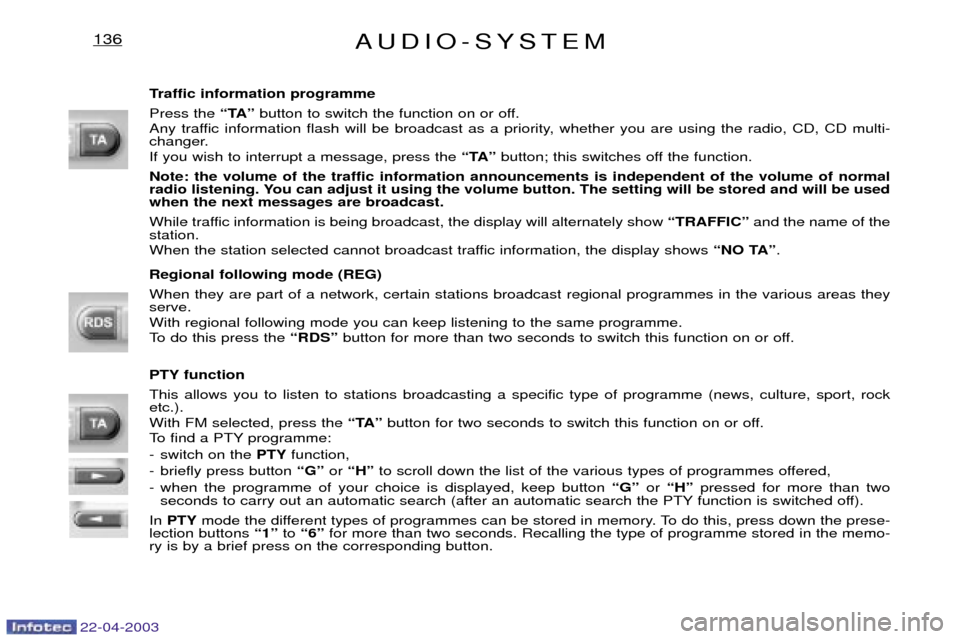
AUDIO-SYSTEM136
Traffic information programme Press the ÒTAÓbutton to switch the function on or off.
Any traffic information flash will be broadcast as a priority, whether you are using the radio, CD, CD multi-
changer. If you wish to interrupt a message, press the ÒTAÓbutton; this switches off the function.
Note: the volume of the traffic information announcements is independent of the volume of normal
radio listening. You can adjust it using the volume button. The setting will be stored and will be usedwhen the next messages are broadcast.
While traffic information is being broadcast, the display will alternately show ÒTRAFFICÓand the name of the
station.
When the station selected cannot broadcast traffic information, the display shows ÒNO TAÓ.
Regional following mode (REG) When they are part of a network, certain stations broadcast regional programmes in the various areas they serve. With regional following mode you can keep listening to the same programme.
To do this press the ÒRDSÓbutton for more than two seconds to switch this function on or off.
PTY function This allows you to listen to stations broadcasting a specific type of programme (news, culture, sport, rock etc.). With FM selected, press the ÒTAÓbutton for two seconds to switch this function on or off.
To find a PTY programme:
- switch on the PTYfunction,
- briefly press button ÒGÓor ÒHÓ to scroll down the list of the various types of programmes offered,
- when the programme of your choice is displayed, keep button ÒGÓor ÒHÓ pressed for more than two
seconds to carry out an automatic search (after an automatic search the PTY function is switched off).
In PTY mode the different types of programmes can be stored in memory. To do this, press down the prese-
lection buttons Ò1Óto Ò6Ó for more than two seconds. Recalling the type of programme stored in the memo-
ry is by a brief press on the corresponding button.
22-04-2003
Page 86 of 128
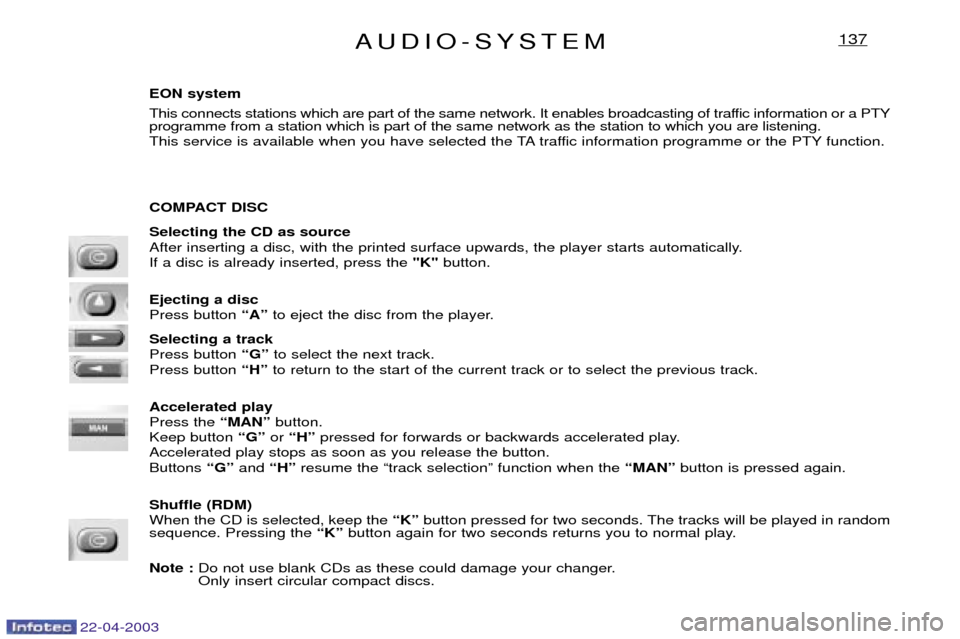
22-04-2003
AUDIO-SYSTEM137
EON system
This connects stations which are part of the same network. It enables broadcasting of traffic information or a PTY programme from a station which is part of the same network as the station to which you are listening.
This service is available when you have selected the TA traffic information programme or the PTY function.
COMPACT DISC Selecting the CD as source
After inserting a disc, with the printed surface upwards, the player starts automatically.If a disc is already inserted, press the "K"button.
Ejecting a discPress button ÒAÓto eject the disc from the player.
Selecting a trackPress button ÒGÓto select the next track.
Press button ÒHÓto return to the start of the current track or to select the previous track.
Accelerated playPress the ÒMANÓbutton.
Keep button ÒGÓor ÒHÓ pressed for forwards or backwards accelerated play.
Accelerated play stops as soon as you release the button.Buttons ÒGÓand ÒHÓ resume the Òtrack selectionÓ function when the ÒMANÓbutton is pressed again.
Shuffle (RDM)When the CD is selected, keep the ÒKÓbutton pressed for two seconds. The tracks will be played in random
sequence. Pressing the ÒKÓbutton again for two seconds returns you to normal play.
Note : Do not use blank CDs as these could damage your changer. Only insert circular compact discs.
Page 87 of 128
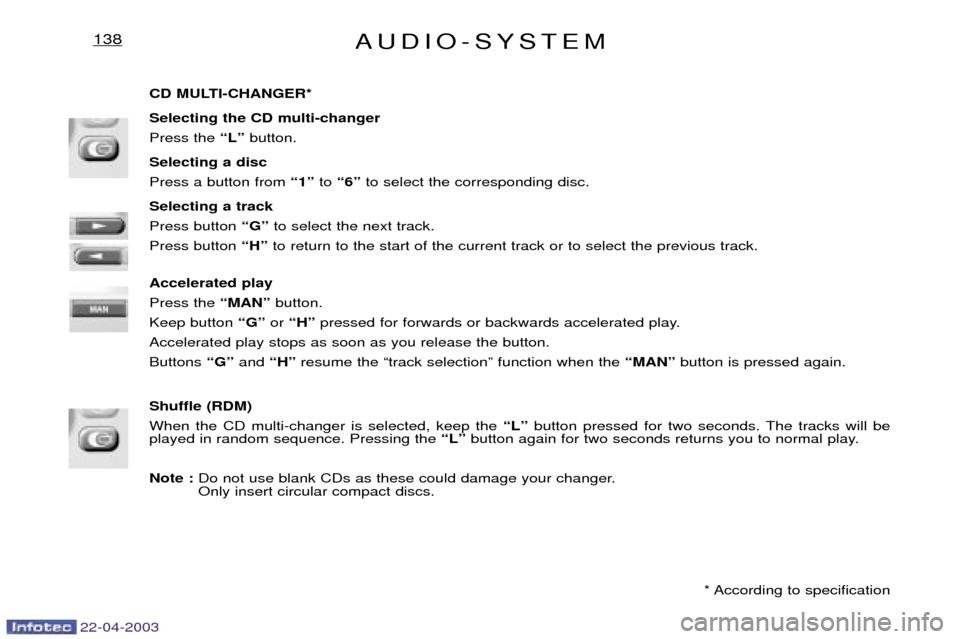
22-04-2003
AUDIO-SYSTEM138
CD MULTI-CHANGER* Selecting the CD multi-changer Press the ÒLÓbutton.
Selecting a discPress a button from Ò1Óto Ò6Ó to select the corresponding disc.
Selecting a trackPress button ÒGÓto select the next track.
Press button ÒHÓto return to the start of the current track or to select the previous track.
Accelerated playPress the ÒMANÓbutton.
Keep button ÒGÓor ÒHÓ pressed for forwards or backwards accelerated play.
Accelerated play stops as soon as you release the button.Buttons ÒGÓand ÒHÓ resume the Òtrack selectionÓ function when the ÒMANÓbutton is pressed again.
Shuffle (RDM)When the CD multi-changer is selected, keep the ÒLÓbutton pressed for two seconds. The tracks will be
played in random sequence. Pressing the ÒLÓbutton again for two seconds returns you to normal play.
Note : Do not use blank CDs as these could damage your changer. Only insert circular compact discs.
* According to specification
Page 88 of 128
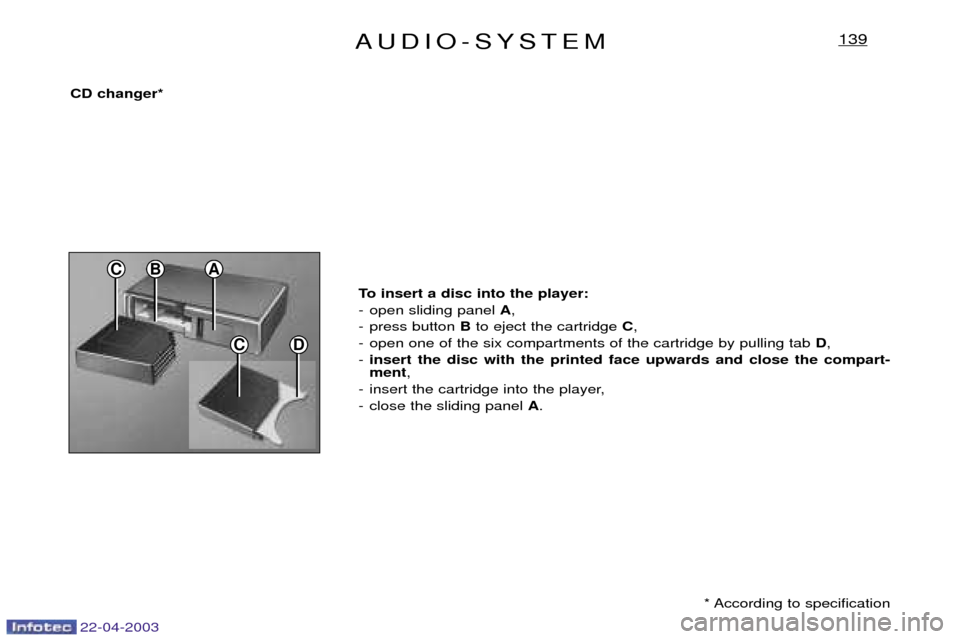
22-04-2003
AUDIO-SYSTEM139
CD
C
CD changer** According to specification
To insert a disc into the player:
- open sliding panel
A,
- press button Bto eject the cartridge C,
- open one of the six compartments of the cartridge by pulling tab D,
- insert the disc with the printed face upwards and close the compart- ment ,
- insert the cartridge into the player,
- close the sliding panel A.
BA
Page 89 of 128
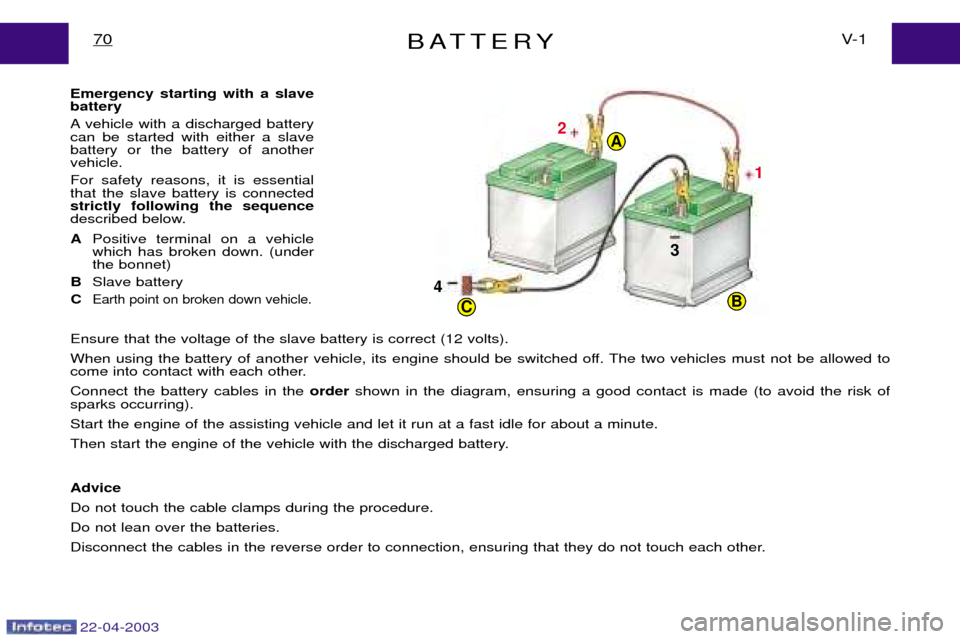
22-04-2003
BATTERYV- 1
70
Emergency starting with a slave battery
A vehicle with a discharged battery can be started with either a slavebattery or the battery of anothervehicle. For safety reasons, it is essential that the slave battery is connectedstrictly following the sequence
described below.
A Positive terminal on a vehiclewhich has broken down. (underthe bonnet)
B Slave battery
C
Earth point on broken down vehicle.
Ensure that the voltage of the slave battery is correct (12 volts).
When using the battery of another vehicle, its engine should be switched off. The two vehicles must not be allowed to
come into contact with each other. Connect the battery cables in the ordershown in the diagram, ensuring a good contact is made (to avoid the risk of
sparks occurring).Start the engine of the assisting vehicle and let it run at a fast idle for about a minute.
Then start the engine of the vehicle with the discharged battery. Advice Do not touch the cable clamps during the procedure.Do not lean over the batteries.
Disconnect the cables in the reverse order to connection, ensuring that they do not touch each other.
2
1
3
4
CB
A
Page 90 of 128
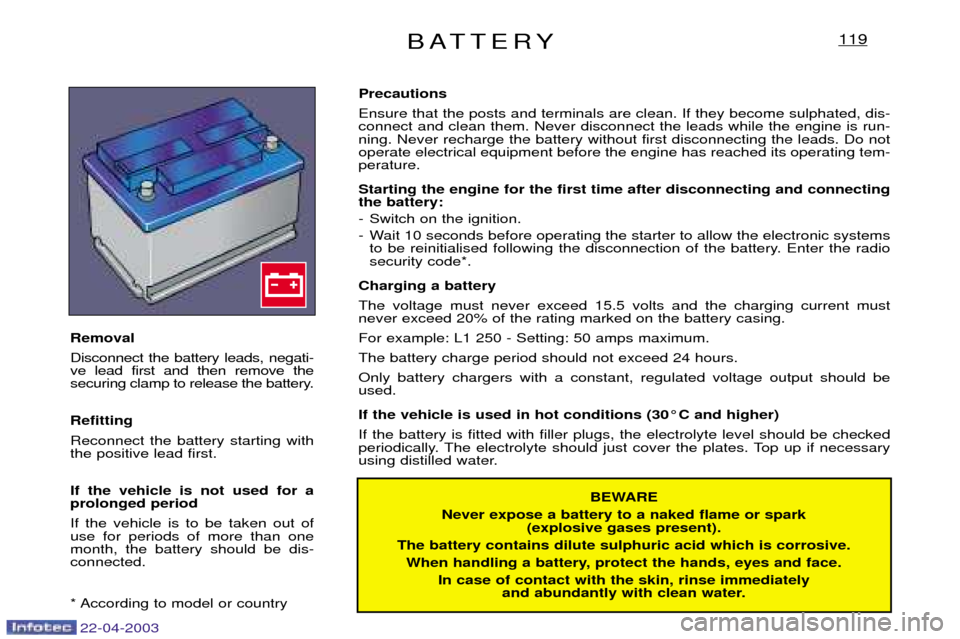
22-04-2003
BATTERY119
BEWARE
Never expose a battery to a naked flame or spark (explosive gases present).
The battery contains dilute sulphuric acid which is corrosive.
When handling a battery, protect the hands, eyes and face. In case of contact with the skin, rinse immediately and abundantly with clean water.
Removal Disconnect the battery leads, negati- ve lead first and then remove the
securing clamp to release the battery. Refitting Reconnect the battery starting with the positive lead first. If the vehicle is not used for a prolonged period If the vehicle is to be taken out of use for periods of more than onemonth, the battery should be dis-connected.
* According to model or country Precautions Ensure that the posts and terminals are clean. If they become sulphated, dis- connect and clean them. Never disconnect the leads while the engine is run-ning. Never recharge the battery without first disconnecting the leads. Do notoperate electrical equipment before the engine has reached its operating tem-perature. Starting the engine for the first time after disconnecting and connecting the battery:
- Switch on the ignition.
- Wait 10 seconds before operating the starter to allow the electronic systems
to be reinitialised following the disconnection of the battery. Enter the radio security code*.
Charging a battery The voltage must never exceed 15.5 volts and the charging current must never exceed 20% of the rating marked on the battery casing. For example: L1 250 - Setting: 50 amps maximum.The battery charge period should not exceed 24 hours.Only battery chargers with a constant, regulated voltage output should be used. If the vehicle is used in hot conditions (30¡C and higher) If the battery is fitted with filler plugs, the electrolyte level should be checked
periodically. The electrolyte should just cover the plates. Top up if necessary
using distilled water.